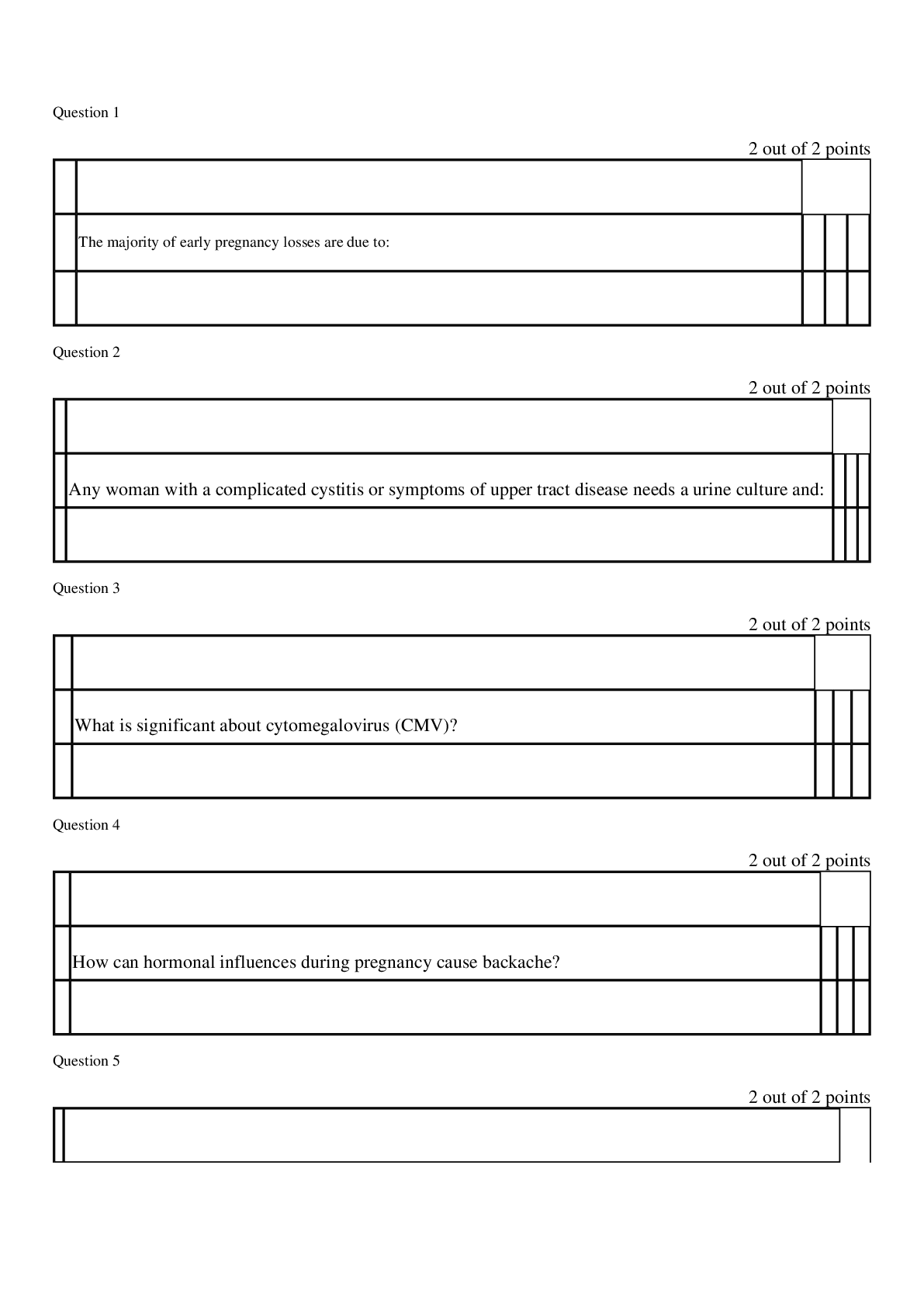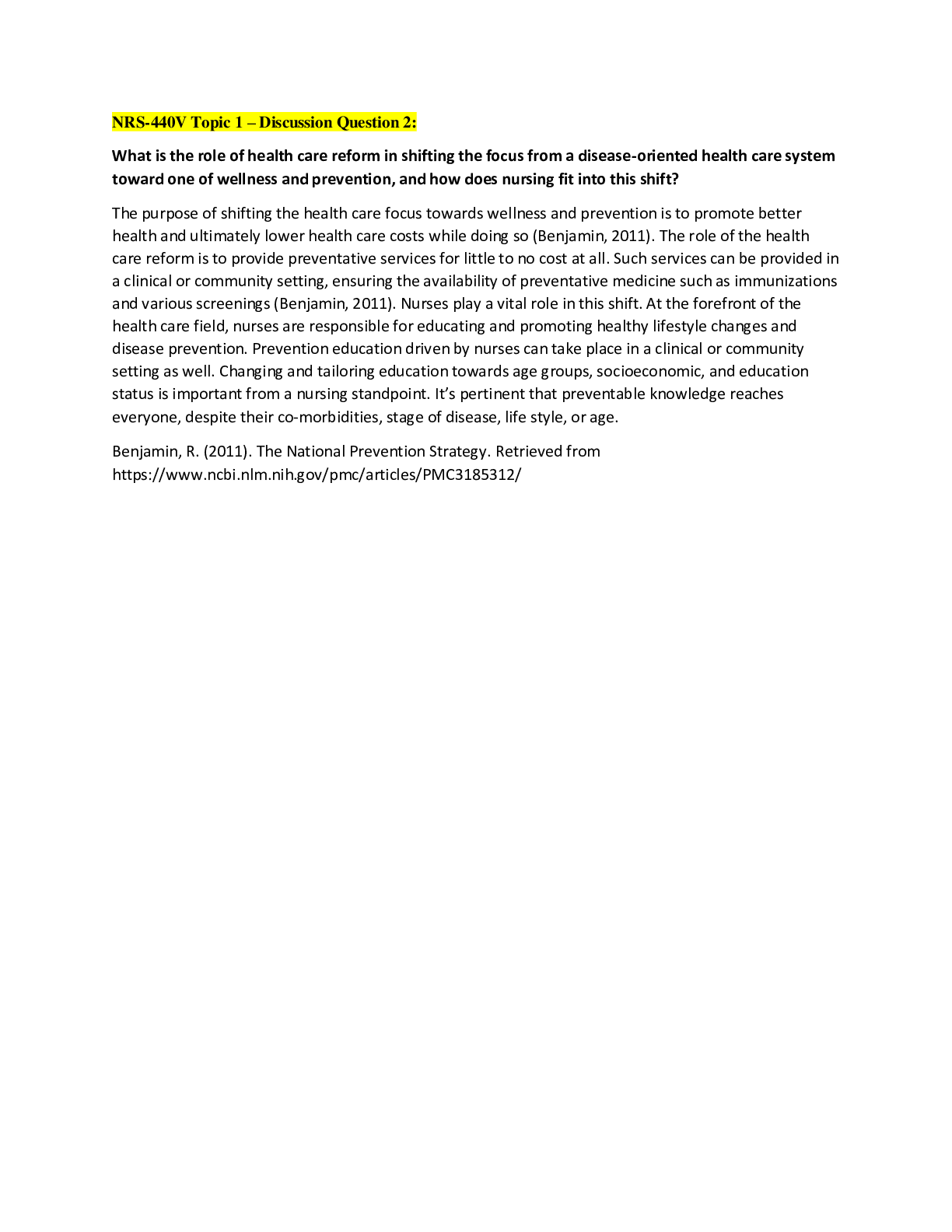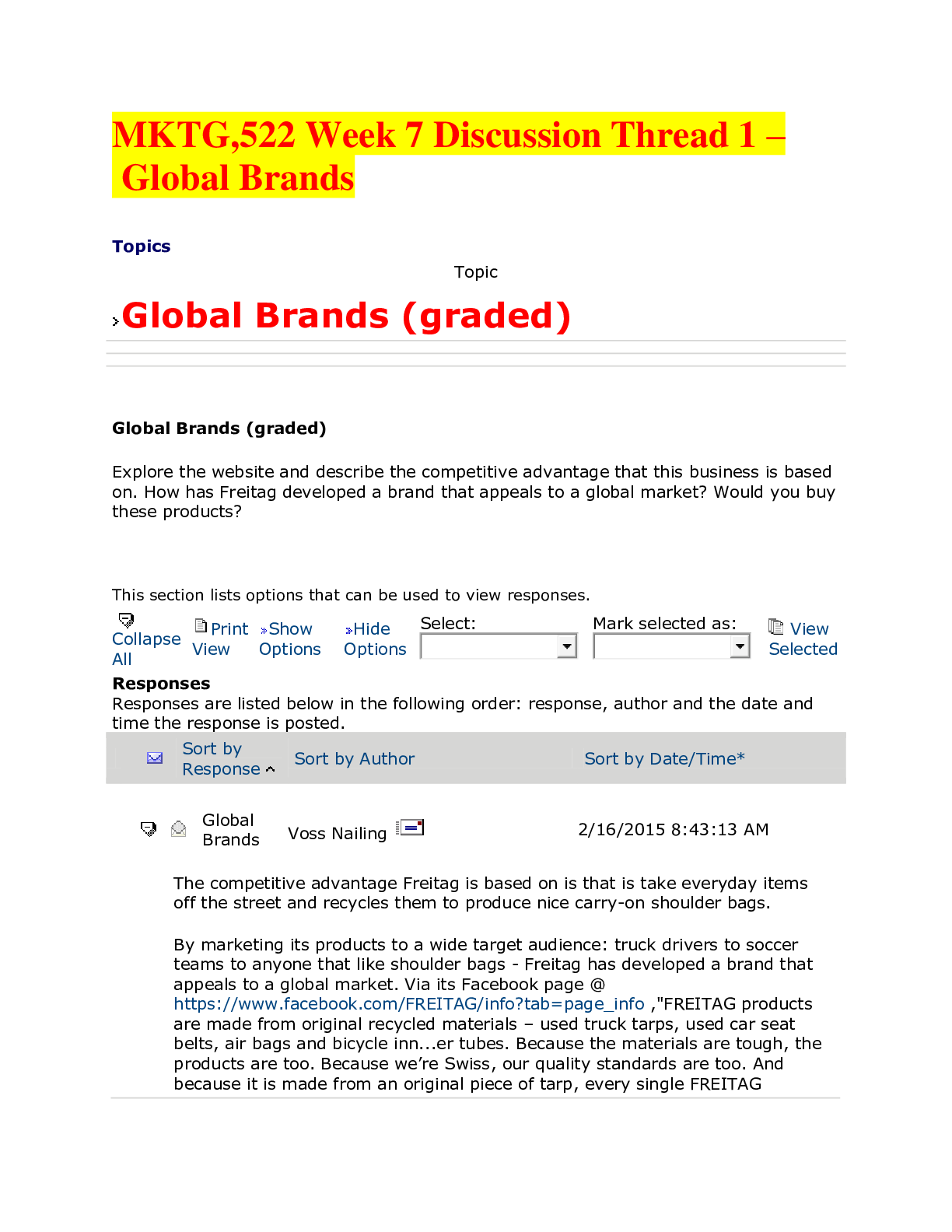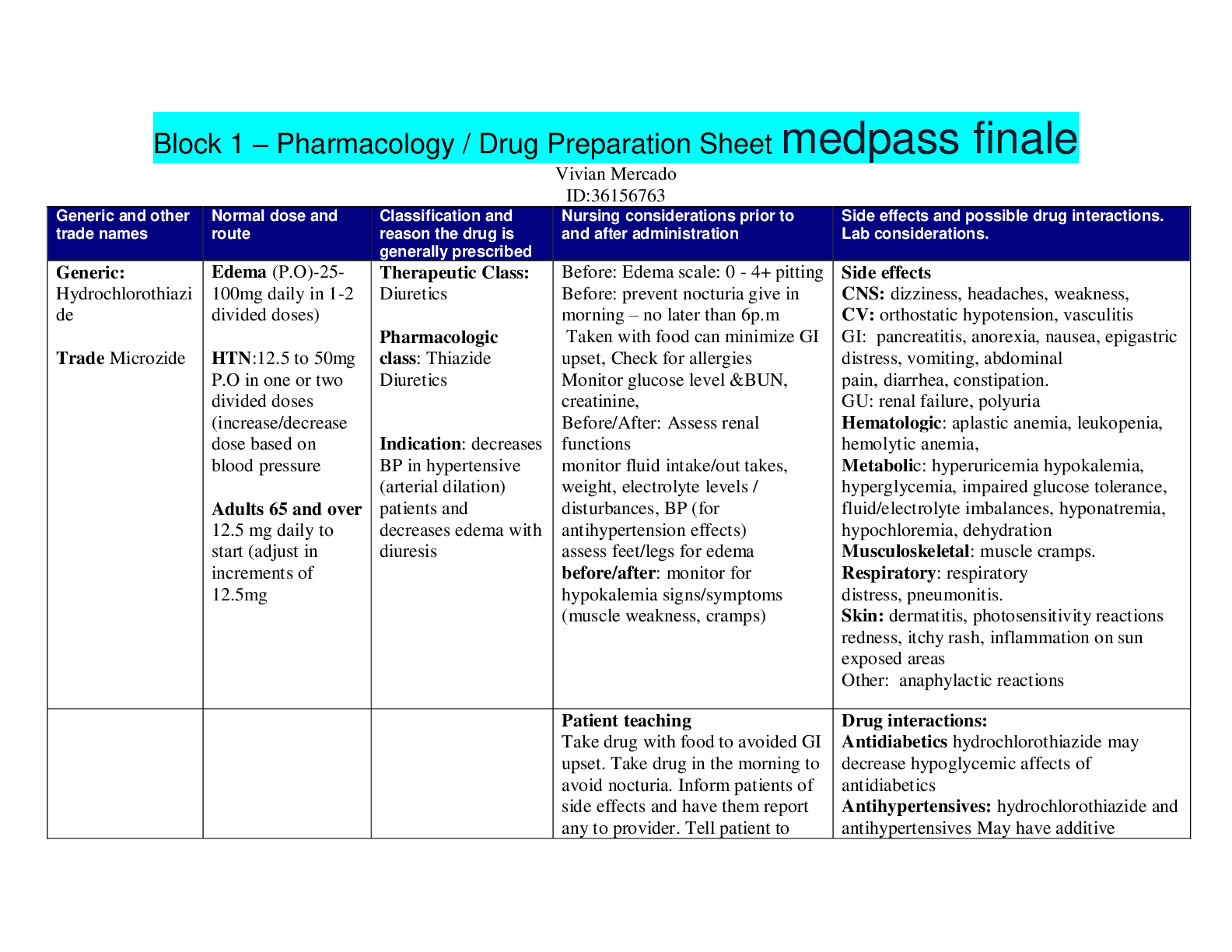*NURSING > STUDY GUIDE > Rasmussen College - NURSING 2349 EXAM 3 Nur 1 – Possible study guide – Key Concepts MODULE 6. (All)
Rasmussen College - NURSING 2349 EXAM 3 Nur 1 – Possible study guide – Key Concepts MODULE 6.
Document Content and Description Below
Nur1 – Exam 3 Possible study guide – Key Concepts MODULE 6 What is Immunity? The normal physiologic response to microorganisms and proteins as well as conditions associated with an inadequa... te or excessive immune response. Local signs of inflammation- pain, heat, redness, swelling, loss of function (severe) B lymphocyte function in immune response (plasma cells, memory cells, Ig cells) Immunoglobulins are responsible for primary response to invading bacteria and viruses and provide the humoral immunity component of an immune response What are the 3 types of T lymphocytes (T cells) 1. Helper T cells (CD4)- helps in functions, regulates most functions via the protein mediators, lymphokines. They direct and encourage other T cells to help activate B lymphocytes. 2. Cytotoxic T cells (killer cells): directly kill foreign antigens and may kill self-cells 3. Suppressor T cells: suppress the function of both helper and cytotoxic T cells in order to prevent hyperimmune responses What is cell-mediated immunity? Immune response that involves the activation of phagocytes, antigen-specific cytotoxic T lymphocytes, and the release of various cytokines in response to an antigen. What is primary immunodeficiency (PI) ? when the entire immune defense system is inadequate and the client is missing some or all of the components for a complete immune response Secondary immunodeficiency (SI) develop for immunocompromised patients ex: MRSA, C-Diff What are the 4 types of exaggerated immune responses? Type I: IgE-mediated or atopic "allergic" seasonal allergic rhinitis, bee stings Type II: tissue specific or cytotoxic Autoimmune thrombocytopenic purpura, Graves' disease Type III: Immune complexmediated ystemic lupus erythematosus Type IV: cell-mediated or delayed hypersensitivity contact sensitivity to poison ivy and metals (jewelry) Common diagnostic tests for Immune Function Primary testing: RBC & WBC count with differential, fluorescent antinuclear antibody, c-reactive proten (CRP),erythrocyte sedimentation (ESR), Disease-Specific testing: allergy testing genetic testing: Rheumatoid factors (RFs), Western blot test, organ function test, TORCH antibody panel Pharmacotherapy for exaggerated immune response corticosteriods and NSAIDs for immunosuppression and pain management What is an immunogen? A substance capable of inducing an immune response Leukocytes WBC, originate from the bone marrow. spend most of their time in storage, in lymphoid tissues, or dispersed throughout the host tissues. How does leukocytes get around? use blood mainly as a transport system to travel to areas of the body where they are needed Six families of leukocytes that have distinct roles inthe body's defense monocyte-macrophages, dendritic cells, mast cells, granulocytes, lymphocytes, and NK cells. Monocytes (Macrophages aka EATERs) are leukocytes found in relatively small quantities in the blood, because most of them are either in the tissues or stored in the bone marrow. Fully differentiated stage is called a macrophage phagocytosis"cell eating" (ex: white blood cells and amoeba) Cytokines Affects the WAY other cells ACT (Cyto- "cell" and -kinein "move") Chemokines Attract other leukocytes to the area to battle the invaders in a process called CHEMOTAXIS Dendritic cells are essential in inducing and maintaining tolerance to BY PRODUCTS OF antigens, keeping the immune system from reacting to the body's antigens Mast cells tend to live near the skin and connective of small blood vessels and contain granules with stored chemicals. When activated, they release substances within the granules (degranulate) that affect vascular permeability, particularly HISTAMINE. Neutrophils A type of white blood cell that engulfs invading microbes and contributes to the nonspecific defenses of the body against disease. Actively involved in bacterial infections most abundant 40-70% 1st responder, dies and turns to pus Neutropenia Deficiency in neutrophils is called Eosinophils defense against parasites & other microorganisms, role in IgE mediated allergic reactions ((redness)) Basophils are the final and most inscrutable granulocyte, appear effective against FUNGUS, role in inflammation Natural Killer [NK] cells Lymphocyte that recognizes and destroys foreign cells responsible for immune surveillance and detection, subsequent destruction of abnormal tissue cells by releasing cytotoxins. B lymphocytes [Mature in bone marrow or thymus] complete their differentiation process and become plasma cells, releasing ANTIBODIES T lymphocytes [Mature in thymus (aka T-cells) cells that mature in the thymus and exist in four varieties, one of which kills antigen-bearing cells Antibody Immune function of B cell Proteins produced by plasma cells that recognize and bind to a specific antigen immunoglobulins (Ig) (antibodies) Y shaped with two recognition segments and one effector segment agglutination Clumping of (foreign) cells; induced by cross-linking of antigen-antibody complexes. PRIMARY LYMPHOID ORGANS Bone Marrow & Thymus Lymphocyte develope and mature SECONDARY LYMPHOID TISSUE: the spleen, lymph nodes, and epithelial lymphoid tissues. they are strategically placed in the body so that invading pathogens will encounter them as early as possible, allowing the immune system to be activated before extensive damage can be done. Innate immune system Immunoglobulins- G- Most abundant, found in all fluids and protects against bacterial/viral o Protects newborn(crosses placenta) high concentrations found within mucous membranes; especially in resp passage and GI tract, as well as tears and saliva o Protects surface from invasion M- first antibody made by body to fight infection; found in blood and lymph fluid o Natural antibodies, heavily in blood typing, E- mainly with allergic reactions (overreacts to environment) found in lungs, skin and mucous membranes o Exocrine secretion. Energy, trigger release of histamine in mast and basophil D- exists in small amounts in the blood, least understood *Age related to immunity-suppressed immunity: Very old and very young are at greatest risks Humoral-mediated immunity: refers to immunity that is mediated by B lymphocytes, plasma cells, and antibodies Cell-mediated immunity: refers to immunity that is mediated by T lymphocytes. Innate immunity- Present at birth, NON-specific response not considered antigen specific, provides immediate protection against effects of tissue injury and foreign proteins, CAUSE VISIBLE SYMPTOMS. o -Components: Tissue barrier; skin, respiratory and GI, mucosa. Cells: neutrophils, macrophages, NK cells. Plasma protein; complements (Adaptive)Acquired immunity- after birth either passively or actively o -Antigen specific, develops after exposure, response slower than innate, MEMORY, Components: Cells, B and T lymphocytes=antibodies and cytokines Actively Acquired Immunity: develops after the introduction of a foreign antigen ACTIVE (ARTIFICIAL)- immunization ACTIVE (NATURAL)- after introduction of pathogen (chickenpox) Passively Acquired Immunity: occurs by introduction of antibodies either by artificial or natural routes PASSIVE (ARTIFICIAL)- transfusion of immunoglobulin IgG PASSIVE (NATURAL)- mother to fetus through placental blood, or breastfeeding Optimal Immune Response: protects the body from invasion, removes dead/damaged cells, recognizes mutated cells (cancer) What is altered Immunity? when immune responses are either suppressed or exaggerated -Suppressed responses AKA immunocompromised or immunodeficiency -Exaggerated responses AKA hypersensitive Suppressed Immune Response (hypo) PRIMARILY: results from improperly developed cells of absence of cells SECONDARILY: loss of immune function from illness or treatment (chemo or autoimmune disease) this causes: risk for infection/ risk for cancer Exaggerated Immune Response (hyper): allergic reactions, cytotoxic reaction, autoimmune reaction What are the 3 lines of defense in an Optimal Immune Response 1. skin boundary: mucous membranes, natural microbial flora, and complement proteins 2. activities of phagocytes, natural killer T lymphocytes, granulocytes & macrophages 3. antibodies derived from B & T lymphocytes Risk factors for Suppressed Immune Response very old/very young, non-immunized, environmental factors (poor nutrition, exposure) , chronic illness (HIV, COPD, Diabetes), genetics, high-risk behaviors & substance abuse, pregnancy Risk factors for Exaggerated Immune Response: gender, race, ethnicity, genetics, environmental/medication exposure What organs are involved with immune responses? AKA lymphoid organs, bone marrow, thymus gland, spleen, tonsils, adenoids, appendix lymphocytes are formed, grow, mature, & released from these organs. Critical point of immune system: body must differentiate between self & non-self cells, when body fails to do so the immune system begins to attack host cells leading to autoimmune diseases and disorders such as Rheumatoid arthritis Blood cells- all derive from within bone marrow in form of either. o Meyeloid= neutrophils, monocytes, eosonophils, basophils and mast cells o Lymphoid cells= B lymphocytes, (mature in thymus) T lymphocytes, Nature Killer cell Substances lacking HLA are identified as nonself Organ transplantation can affect immune function in several ways. Most transplanted organs will be attacked as nonself by the adaptive immune system. Immunosuppressive drugs are usually indicated throughout the rest of the patient’s life, putting the patient at risk for both acquired infections and opportunistic infections. Heart transplant patients receive a double hit to the immune system because the thymus is usually removed along with the dysfunctional heart, and they receive immunosuppressive therapy Neutropenia often occurs within 7 to 10 days after a block of chemotherapy is completed The dendritic cell is the key to the activation of the immune system Stress and social support can have a dramatic impact on immune function Allergic diseases are common, affecting about 15–20% of the population Atopy is an inherited tendency for hyperproduction of IgE antibodies to common environmental allergens [Show More]
Last updated: 2 years ago
Preview 1 out of 24 pages

Buy this document to get the full access instantly
Instant Download Access after purchase
Buy NowInstant download
We Accept:

Reviews( 0 )
$15.00
Can't find what you want? Try our AI powered Search
Document information
Connected school, study & course
About the document
Uploaded On
Jan 20, 2021
Number of pages
24
Written in
Additional information
This document has been written for:
Uploaded
Jan 20, 2021
Downloads
0
Views
141
























.png)

